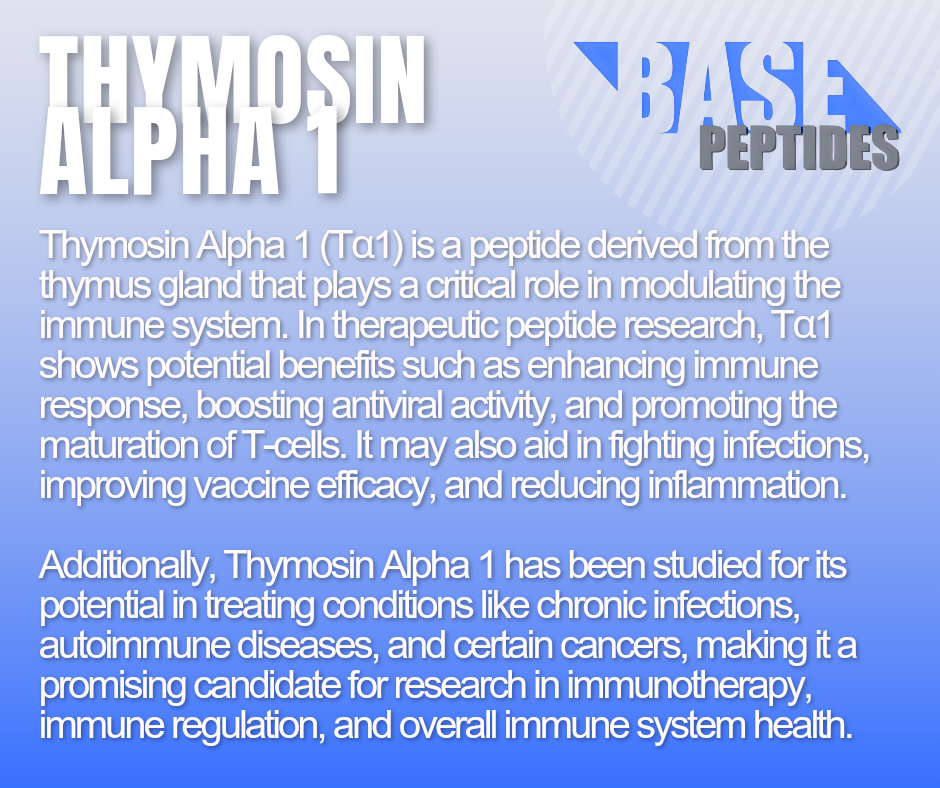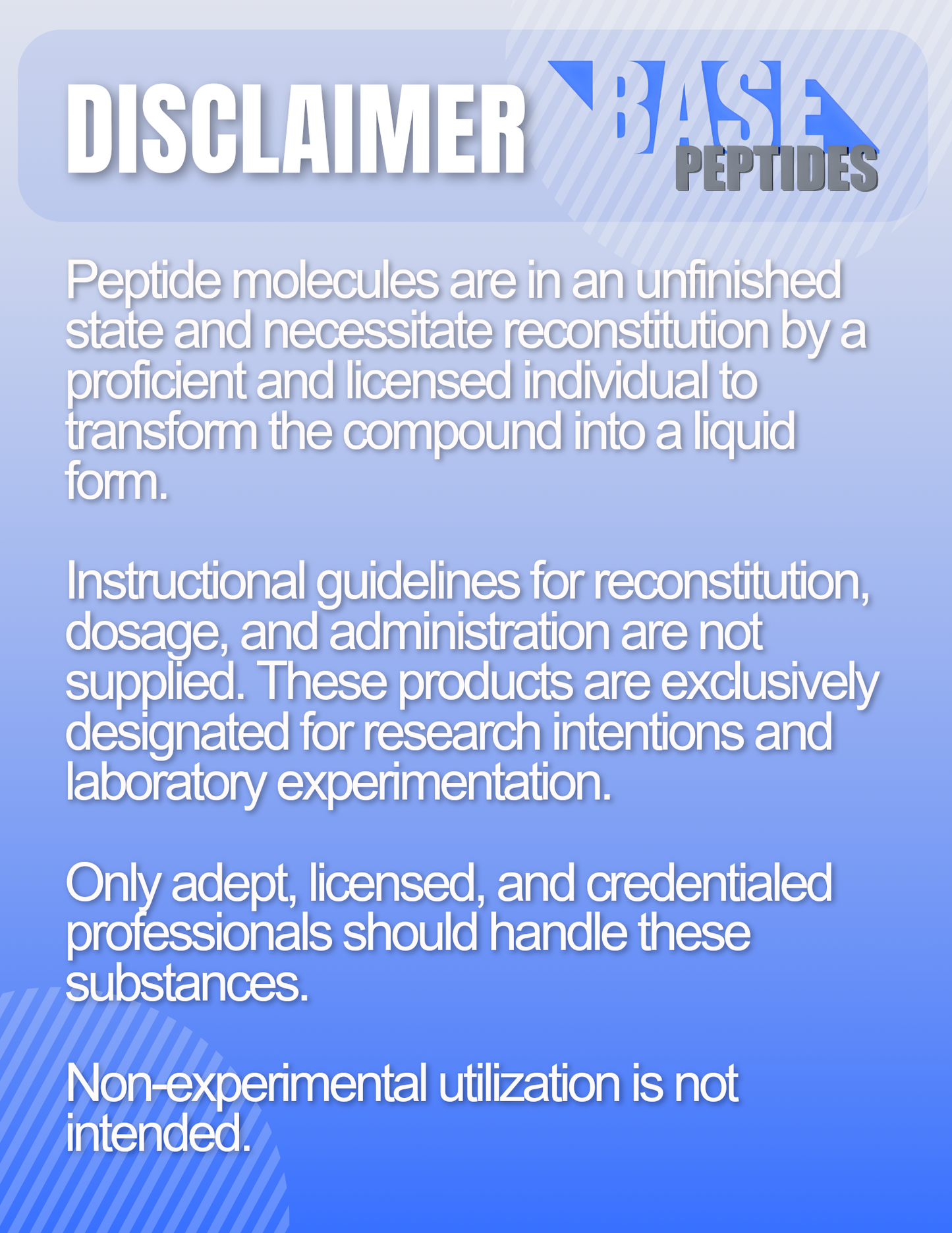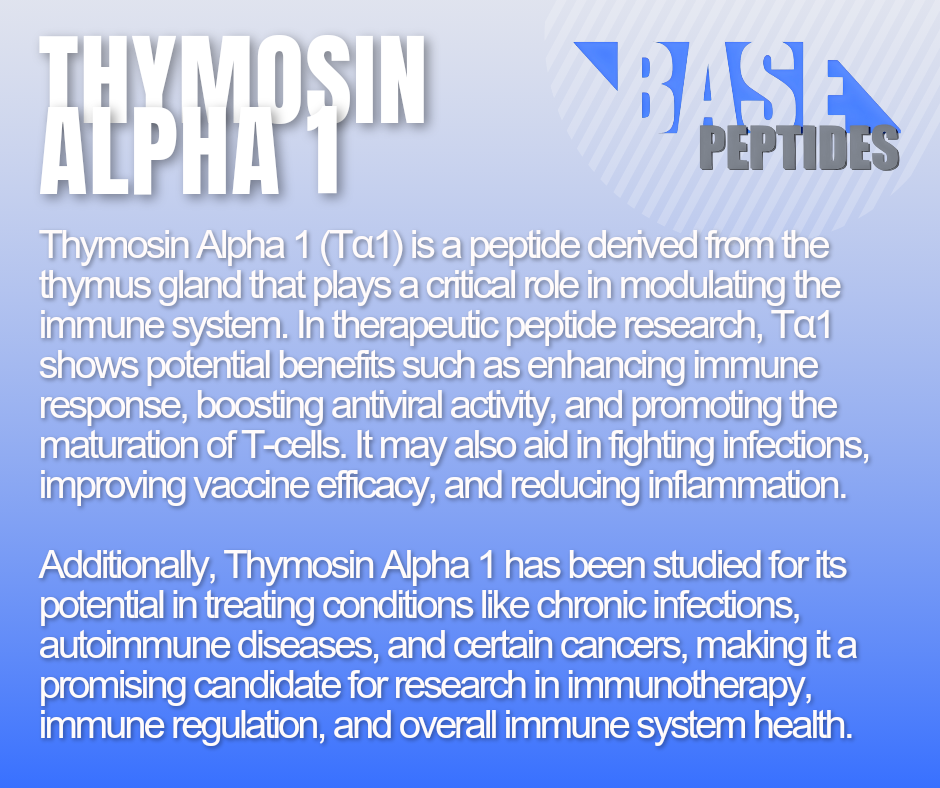Thymosin Alpha 1
Thymosin Alpha 1
Base Peptides are intended for licensed medical professionals and experienced researchers. Reconstitution required. Dosing and use instructions are not provided.
Couldn't load pickup availability
Thymosin-α1 (Tα1 / Thymalfasin) — 28-Amino-Acid Immune-Signaling Peptide
Thymosin-α1 is a naturally occurring 28-residue peptide generated from prothymosin-α. In research, it’s used to study innate–adaptive immune coordination, dendritic-cell/T-cell activation, and antiviral host-defense signaling.
- CAS: 62304-98-7
- PubChem CID (Thymalfasin): 16130571
- Formula / MW: C129H215N33O55 · ≈ 3,108 Da
- Sequence (human): Ac-Ser-Asp-Ala-Ala-Val-Asp-Thr-Ser-Ser-Glu-Ile-Thr-Thr-Lys-Asp-Leu-Lys-Glu-Lys-Lys-Glu-Val-Val-Glu-Glu-Ala-Glu-Asn-OH (28 aa)
- Origin: N-terminally acetylated fragment of prothymosin-α (PTMA)
- Tα1 engages innate sensors (reported activity at TLR2/TLR9 on antigen-presenting cells) that help prime adaptive T-cell responses.
- It’s often used to explore Th1-leaning immune balance, antigen presentation, and antiviral gene programs in preclinical systems.
- Because it’s a defined peptide, researchers can test dose–response and timing with clean readouts vs. complex biologics.
- To study dendritic-cell maturation and T-cell priming in vitro/in vivo models.
- To analyze host-defense pathways in viral or bacterial challenge paradigms.
- To map innate–adaptive cross-talk with precise peptide exposures.
Key Studies — What Was Tested, What Changed, Why It Matters
Innate sensors → adaptive activation
- What was tested: Antigen-presenting cell exposure to Tα1 with downstream T-cell readouts.
- What changed: Increased markers of APC activation and improved T-cell responses in multiple models.
- Why it matters: Helps labs dissect how short peptides can bridge innate and adaptive immunity.
Antiviral & host-defense signaling
- What was tested: Preclinical and clinical-context literature on Tα1 in viral disease models (e.g., hepatitis; respiratory infections).
- What changed: Reports of enhanced cell-mediated immunity and improved immune balance; findings vary by model and cohort.
- Why it matters: Offers a mechanistic tool for probing antiviral readiness and Th1/Th2 balance in controlled settings.
Translational context (regulatory/overview)
- What was reviewed: FDA background summary on Tα1 bulk substance chemistry (free base vs salt), formula, and safety testing ranges.
- Key notes: Confirms CAS 62304-98-7, formula C129H215N33O55, and provides nonclinical exposure ranges; use for research-context only here.
Potential Research Applications
Innate → Adaptive Mapping
- APC maturation and antigen-presentation assays
- Th1/Th2 cytokine panels and T-cell function
Host-Defense Models
- Antiviral readiness and interferon-linked genes
- Vaccinology adjuvant-style investigations
Systems Immunology
- Gene-expression arrays and pathway enrichment
- Time-course designs for dose/timing effects
Synergistic Peptides (for Study Design)
Selank
- Why pair: Neuroimmune balancing—useful alongside Tα1’s immune-priming studies.
- Angle: Cytokine profiles (Th1/Th2) plus behavioral-stress markers.
BPC-157
- Why pair: Tissue/gut barrier models with inflammatory readouts that complement immune signaling.
- Angle: Barrier function + cytokine panels in co-culture systems.
TB-500 (Tβ4 fragment)
- Why pair: Matrix/motility signaling to contrast with immune-centric endpoints.
- Angle: ECM markers + immune-cell recruitment in repair-biology models.
Design Notes
- Define timing (pre-, co-, or post-challenge) and dose precisely—immune outputs are time-dependent.
- Use standardized media/serum lots; cytokine assays are sensitive to background noise.
- Document peptide salt/form, vehicle, pH, light exposure, and storage.
Known Concerns (Context)
- Model variability: Outcomes depend on pathogen type, challenge dose, and host model/strain.
- Assay design: Include both innate and adaptive endpoints to avoid partial interpretations.
- General: Research use only; not for human consumption or therapeutic use.
Handle under cold, low-light conditions; prepare fresh aliquots and avoid repeat freeze–thaw cycles.
Specifications & Handling
- Form: Lyophilized powder (lot-coded)
- Purity: ≥ 99% (HPLC/MS verified)
- Storage: ≤ −20 °C; protect from light/moisture
- In solution: Aliquot promptly; avoid repeat freeze–thaw
- Additives: None unless specified per lot
- Packaging: Tamper-evident; research-only labeling
Regulatory & Use Notice
Sold for laboratory research use only. Not for human consumption, medical, or veterinary use. No human-use instructions are provided. Buyer is responsible for safe handling and regulatory compliance.
Thymosin-alpha 1 (Tα1, Thymalfasin) Peptide Research | Immune Signaling, APC/T-cell Activation, Antiviral Host Defense






